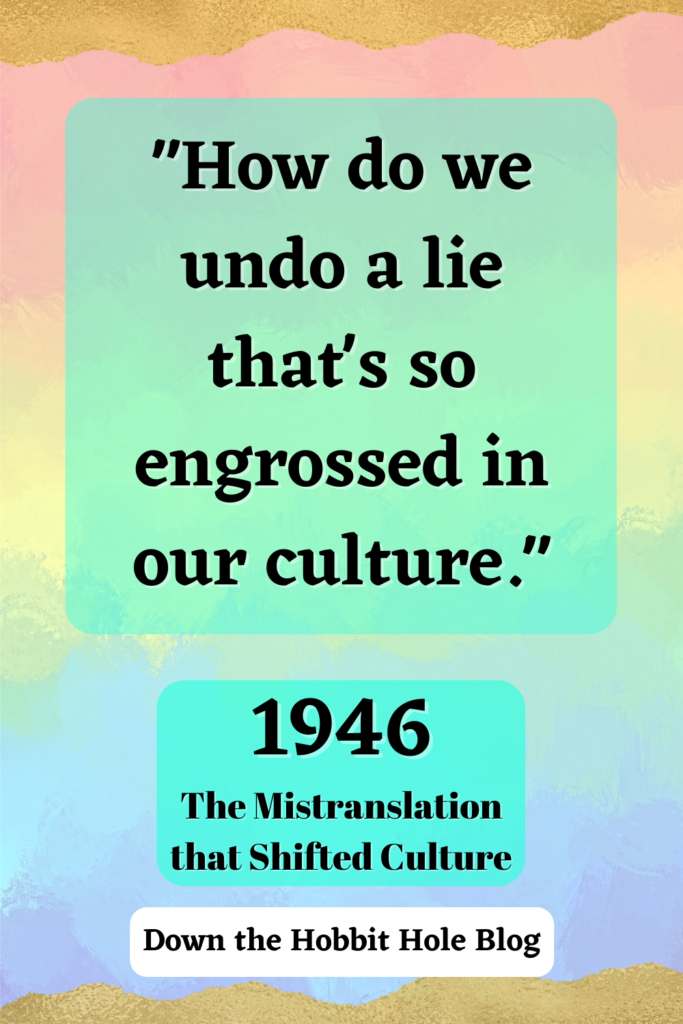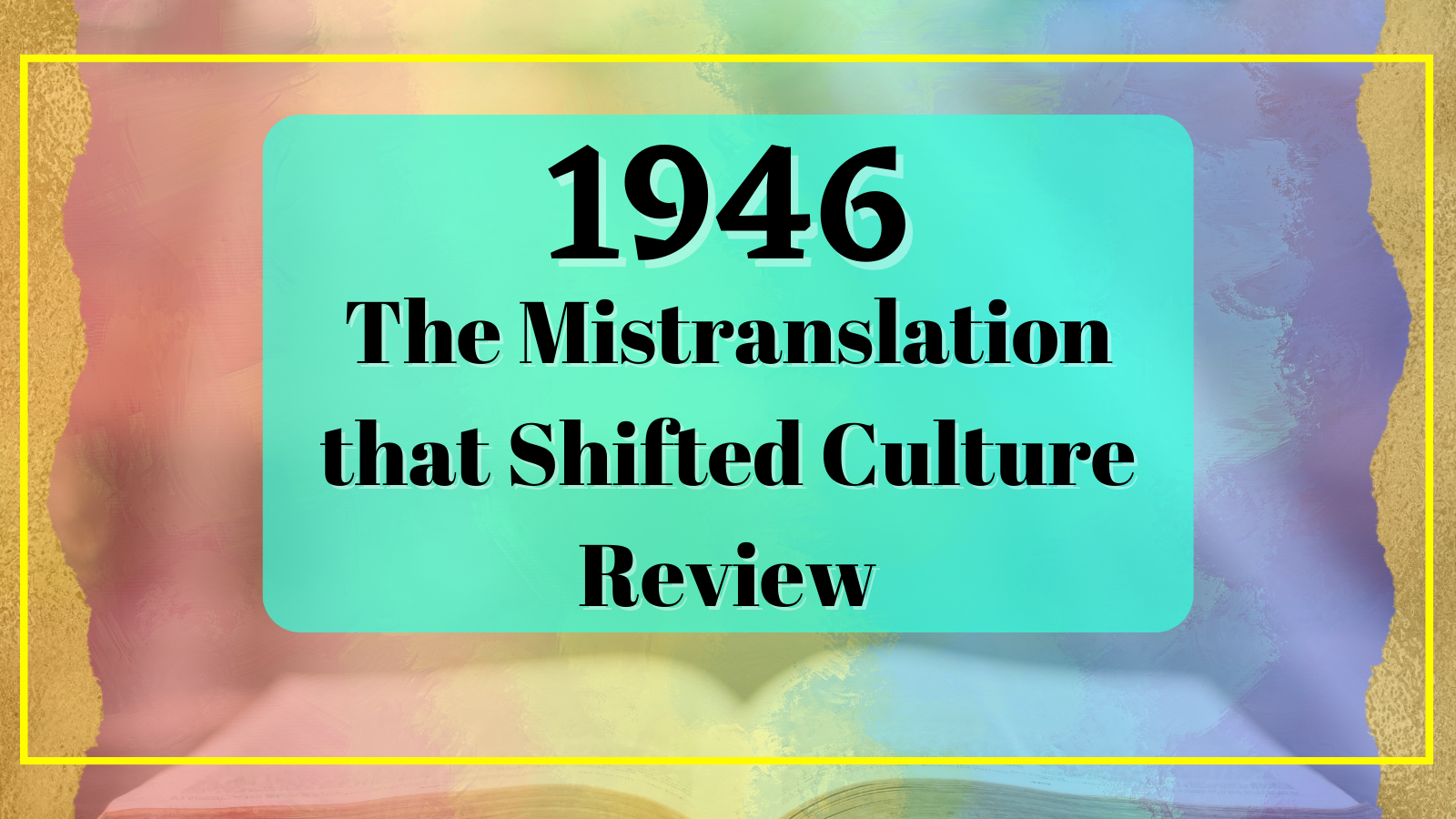Lessons from the 1946 Documentary written by the Elf and the Hobbit.This post contains affiliate links, you can find out more on our policies page or in the disclaimer at the bottom of the blog.
5 Lessons from the New Documentary
‘1946: The Mistranslation that Shifted Culture’
A Film about Loving God, The Word,
and Other People Well.
Know Before You Watch the 1964 Documentary
The Mistranslation that Shifted Culture
Movie: 1946: The Mistranslation that Shifted Culture
Genre: Documentary, Christian, LGBTQ+
Length: 1 hr. 32 mins.
Age suggested: 13 and up (with parents)
Warnings: Lots of discussion about LGBTQ+ trauma, mostly caused by theology, church and academic hurt
Quick 1946 Documentary Summary
After discovering a mistranslation, a group went on a mission to educate the public on the misinformation regarding the word “homosexual” in the Bible. It dives into the academic realm where the words of Paul and those in the old testament have been misconstrued over the last century. There is also a through line that delves into the reality of people’s theology and discusses paths of reconciliation and healing. The 1946 documentary is, in itself, a summary of the creator’s journey so far.
Why Watch the 1946 Documentary
1946 was a very well made and informative documentary. It follows the stories of 3 people as they research how to be faithful to God and his word. I appreciate that the documentary specifically focused on being educational and reconciliatory over being aggressive and condemning. This film is an excellent discussion starter. And while you won’t come away knowing every single argument to the difficult Biblical passages they discuss, you will have a really good starting point.
1946 is an encouraging, but also potentially triggering, watch for those who are exploring their religious and sexual identities. Personally, I’ve only been an ally for a few years and am struggling through my own church hurt and religious identity- and this was a hope filled watch. And it didn’t have to end up that way. I’m thankful for Rocky and Kathy’s ministry. And I loved how they ended it. God loves you.
Lessons from the 1946 Documentary
Being Christian and LGBTQ+ can be a Very Isolating Experience
I spent a lot of my 20s wondering how people could be Christian and LGBTQ. Not because I thought it was theological or morally disconnected, but simply because being a Christian without a supportive community seemed so isolating. This documentary gives real life stories from people who experience this isolation personally. They also show that community is worth the hunt and it is out there. It just requires searching. It also highlights how there are so many ‘welcoming and inclusive’ churches out there that really aren’t. As Brene Brown says “Kind communication is clear communication”. Don’t lie about it and pretend to be welcoming if you’re going to limit your LGBTQ+ members in any way.
Quotes like these were heartbreaking. “That’s why it feels like to disconnect and leave this planet would be very easy to do because I’m not really a part of it. Because the church tells me I’m not a part of it. The world tells me I’m not a part of it.” And they are not isolated cries. The church at large must stop subduing and ignoring these words.
The Mistranslation is Rooted in Homophobia, greed, AND Misogyny
Recognizing that this is a mistranslation would also mean recognizing the harm done to women and that greed is not actually a Biblically positive thing (oh hello there Christian nationalism, patriarchy and capitalism). What is the sin of Sodom really? “Now this was the sin of your sister Sodom…arrogant, overfed and unconcerned; they did not help the poor and needy. They were haughty and did detestable things before me.” Ezekiel 16:49-50. Theologian Marg Mowczko has a good, quick, read on not isolation New Testament passages and remembering that the culture was very different for the early church here.
“It’s difficult to imagine solving the problem of intimacy, love, and companionship of men before addressing, head on, the demotion of women in cultures.”
Reviewing historical Documents Can Help us Correct our Present
Out of the seven clobber passages weaponized against LGBTQ+ people in the Bible, most were interpreted very differently 100 years ago. All could be interpreted in a different way today. This isn’t because we are “changing the Bible,” but rather we are undoing a wrong from the past by bringing in knowledge from the past. The translators that put homosexual into the Bible actually agreed to take it out of the final version originally, but by then it was too late. A paraphrasing, modern language Bible, popularized by Billy Graham’s crusades had already taken that one passage and put it into seven verses total.
“I wanted to see what was in the Bible before the word ‘homosexual’ was there.”
We’ve Weaponized a Mistranslation
With LGBTQ+ violence on the rise, the abuse and misunderstanding of this community must be acknowledged and dealt with. And the church needs to reconcile with the harm it has caused to marginalized groups. Even in 1939, the weaponization of these passages was a concern and unfortunately it is now a reality and has been for decades. Emily Calandrelli recently said “love the sinner, hate the sin’ is a cowardly way to be homophobic.” Even though it is nice to think what may have happened if this hadn’t become a cultural issue in America, it is more important to find a way for repentance and reconciliation. And to continue to learn more about what it truly means to love and include as God does.
“I am more deeply concerned because well-meaning and sincere, but misinformed and misguided people may use this Revised Standard Version translation of I Corinthians 6:0-10 as a sacred weapon”
Open Communication is the Only Way Forward
This is perhaps one of the more interesting aspects of the documentary. The counter arguments mostly came from Sal, the father of the creator of the documentary (who is also a retired pastor). They do a good job at not making him the villain, but casting him as the person who is set to their point, but willing to discuss it. Not being able to convince everyone shouldn’t stop you from living your life well and ministering to others. It is important, within reason, to work on these difficult relationships and conversations for the glory of God. That being said- healthy boundaries are also extremely important. And I think they also do a great job of showing that.
“As long as we are talking to one another, there is still hope.”
1946 Documentary Quotes

“I believe that my family and anyone who oppresses the LGBTQ community. I believe they are victims of bad theology.”
“I wanted to see what was in the Bible before the word ‘homosexual’ was there.”
“If you look at a text in multiple translations and you see wide divergences or even confusion, that’s a pretty good clue for you that there’s something difficult here.”
“How do we undo a lie that’s so engrossed in our culture.”
“I am more deeply concerned because well-meaning and sincere, but misinformed and misguided people may use this Revised Standard Version translation of I Corinthians 6:0-10 as a sacred weapon”
“I was too sheltered in the early 90s to realize that my sexuality was becoming a political issue nor did I realize how much the Bible had been amplified as a weapon against the LGBTQ community.”
“It’s not wonder my parents were afraid for me with this kind of propaganda circulating obviously scripted to put gays in the worst light possible.”
“It’s difficult to imagine solving the problem of intimacy, love, and companionship of men before addressing, head on, the demotion of women in cultures.”
“By reading these texts without addressing what’s happening to the women in these texts, it says that that is Christian. It is Christian for a man to rape a woman. That’s horrible!”
“That’s why it feels like to disconnect and leave this planet would be very easy to do because I’m not really a part of it. Because the church tells me I’m not a part of it. The world tells me I’m not a part of it” *If you or someone you know is feeling suicidal there are resources to help- find support hotlines here. *
“As long as we are talking to one another, there is still hope.”
-1946 Documentary Quotes
1946 Documentary Discussion Questions
For Individuals/Families
- How did this documentary affect your view of translations and it’s effect on culture?
- Do you know anyone that takes Sal’s view of homosexuality? How do you interact with them?
- Does the 1946 Documentary change any of your views or give you any actionable items in your life?
For Churches/Small Groups (Can start with the individual ones above)
- How does your church/small group engage with the LGBTQ+ community? Are they transparently honest about how they treat LGBTQ+ members?
- How does your theology affect your view of the LGBTQ+ community? How does your theology inform you how to interact with people who you don’t agree with altogether?
- In what ways could you interact with people with differing opinions than yourselves while maintaining civility?
Thanks for reading our Lessons from the 1946 Documentary.
Before you go, check out these other resources:
Other Resources to Check Out:
-The 1946 website
–Walking the Bridgeless Canyon by Kathy Waldock. Also, here’s her website
–The Beloved Arise Page
–The Free Mom Hugs Page
–Kind Cotton page
–Reformation Project Resources
Down The Hobbit Hole Blog and these Lessons from the 1946 Documentary use affiliate links. We only link products we think you’ll like and you are never charged extra for them. As Amazon Associates, we earn from qualifying purchases at no additional cost to you. All images used in this post were either original designs from Canva or used from media kits We also use cookies to gather analytics and present advertisements. Find our other reviews with discussion questions here. And our posts about family stuff here.
